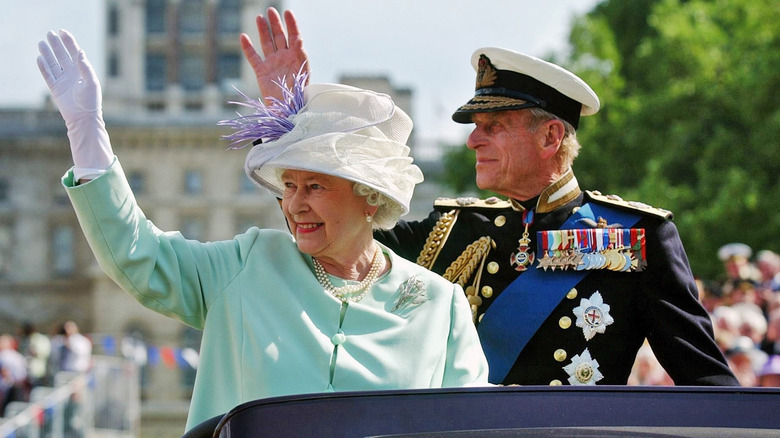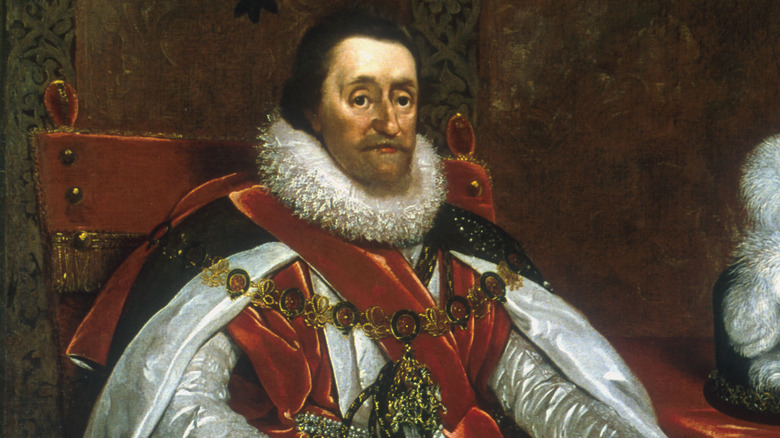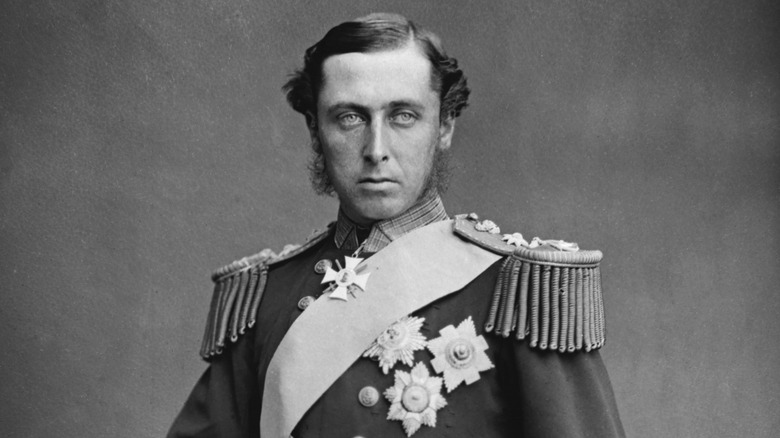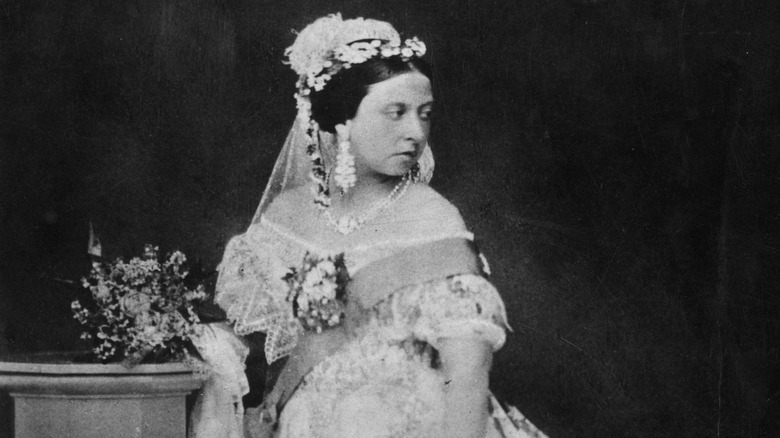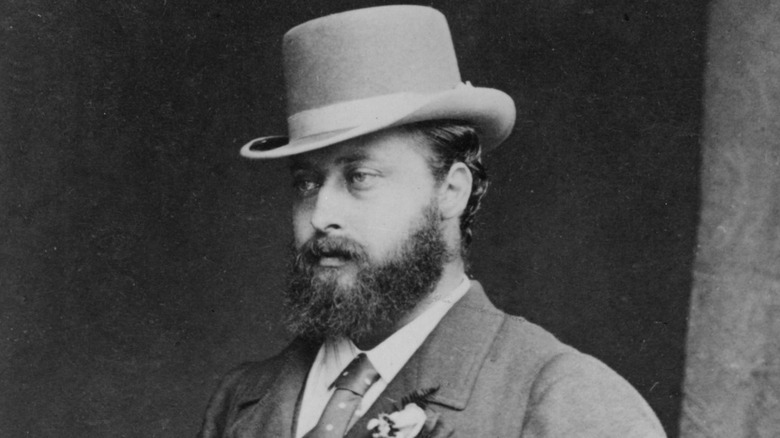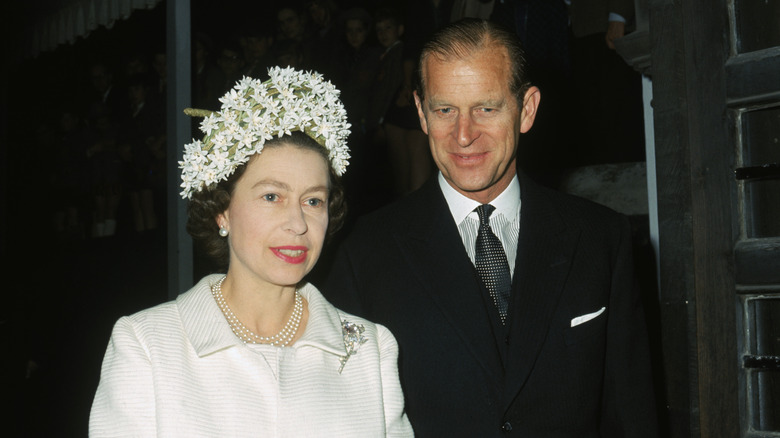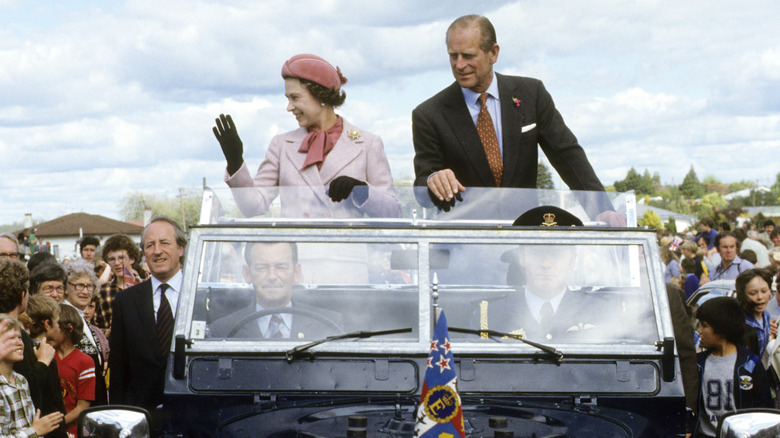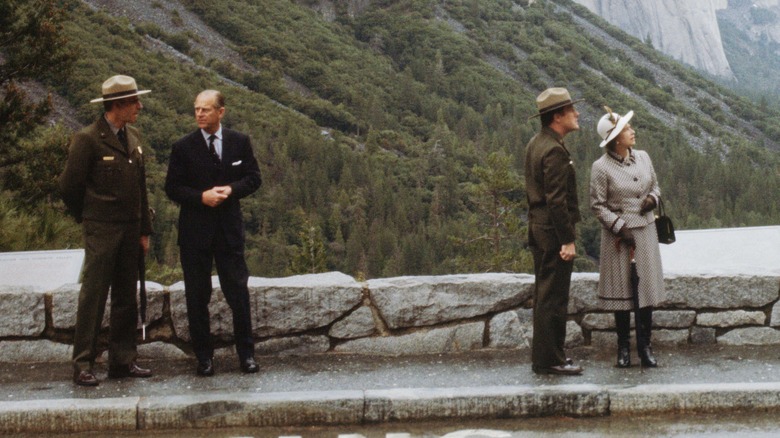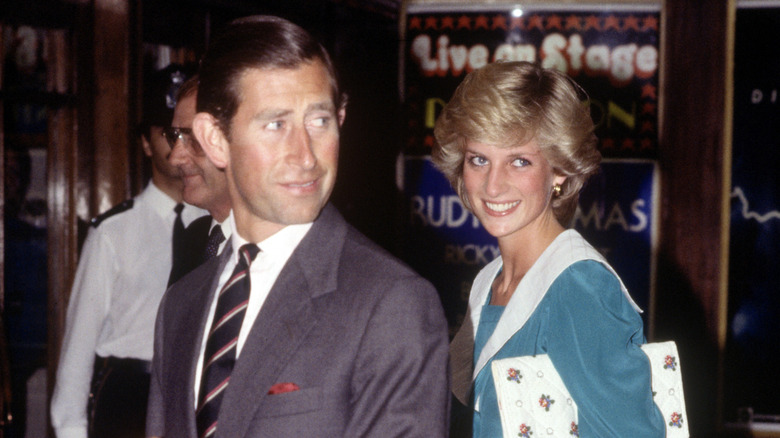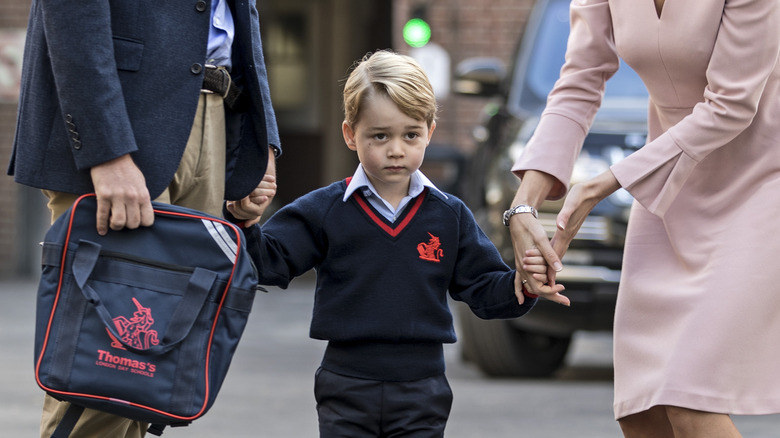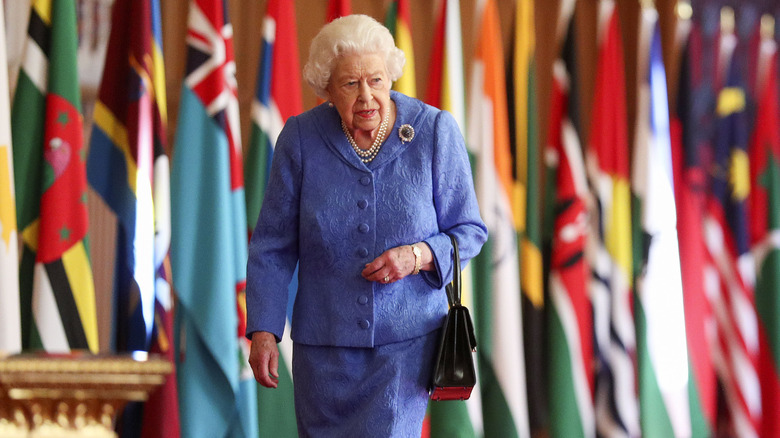Details Revealed About The Assassination Attempts Made On The Royal Family
Royal assassination attempts are generally few and far between — but when they do happen, they tend to leave the public asking why. Of course, the answer is incredibly complicated; however, some perpetrators have cited social, historical, and political reasons for trying to harm a member of the monarchy. After all, the British royal family may be international superstars, but they're not exactly the world's most beloved people. From their past royal scandals to the monarchy's economic burden on taxpayers, the firm is an endless source of controversy. While none of these issues justify murder, they do provide insight into the minds of some would-be royal assassins.
The monarchy's image has also been sullied by the horrors of imperialism. At its peak, the British Empire had spread to 24% of the globe and ensnared millions of colonized people into England's colonial project. As historian Caroline Elkins told Vox, "The monarchy very much wraps itself up into the empire — deploying its symbols, its images, its familial language." This helps us to understand why animosity toward the royals isn't an exclusively English phenomenon — it's also worldwide.
King James I survived an infamous murder plot in 1605
Royal assassination attempts may be disturbing, but they're certainly nothing new. Indeed, the royal family has been dodging assassins since time immemorial. Given their controversial history, it's no surprise that one of the most famous assassination schemes dates back some four centuries to King James I.
For several generations, England was plagued by a power struggle between Protestants and Catholics. In 1534, King Henry VIII famously founded the Church of England in a bid to establish Protestantism as the dominant religion. Henry's actions enraged Catholic leaders, who vowed to reclaim power over England. Religious tensions came to a head in the 1600s, during the reign of King James I.
In 1605, a group of Roman Catholics hatched a plan — known as the Gunpowder Plot — to bomb Parliament and the royal family. The plan involved placing around 1.5 tons of gunpowder in a cellar underneath the House of Lords. The conspirators planned to set off an explosion during the opening of Parliament and take several captives. They expected that the blast would force the government to hand over its power, which would allow the group to reinstate Catholicism as the official religion of England. However, an insider exposed the plot to a government official who stopped the scheme in its tracks. Today, England celebrates Guy Fawkes Day on November 5th to commemorate the quashing of the Gunpowder Plot.
Prince Alfred was shot by a would-be assassin
By the 1860s, relations between England and Ireland had reached a boiling point. However, conflict between the two nations was nothing new. The centuries-long English occupation of Ireland had spawned countless military clashes and sparked an Irish nationalist movement known as Fenianism. Fenians operated as a secret society and sought to reclaim Irish control over Ireland. In 1868, Prince Alfred felt the consequences of the conflict when he was shot by a would-be assassin.
The assassination attempt occurred halfway across the globe in Sydney, Australia. Alfred was attending a fundraising event when a man emerged from the crowd brandishing a handgun. The assailant fired at Alfred, striking the royal in the back. As The Sydney Morning Herald reported on March 13,
1868, "Before his Royal Highness could reply, a treacherous assailant, who had just left the crowd of persons congregated under the shade of trees, stole up behind him and when he approached to within five or six feet pulled out a revolver, took deliberate aim, and fired." According to eye-witness reports, the wounded prince crumpled to the ground and shouted, "Good God, my back is broken!" The assailant turned out to be a Fenian named Henry James O'Farrell. O'Farrell immediately fled the scene but was later captured and executed. As for Prince Alfred, he was lucky to have survived. After a brief hospital stint in Sydney, the royal healed up and was cleared to return home to England.
Queen Victoria survived several assassination attempts
Queen Victoria ascended the throne in 1837 and ruled for 63 years. The Victorian Era — as her reign came to be known — was characterized by ups and downs. On one hand, the monarch won popularity points by taking an interest in public life and overseeing a golden economic age in England. However, Victoria also made plenty of enemies during her time. For starters, the monarch broke royal protocol with her blatant partisanship and her fervent support for England's Whig Party. She was also criticized for her inaction during the Irish Potato Famine, which killed and displaced millions of people. Throughout her life, the controversial queen endured at least eight assassination attempts.
Between 1840 and 1882, Victoria survived five shootings. In one of those cases, a man named John Frances attempted to shoot the monarch while she sat in her carriage. When his gun jammed, Frances returned the next day and managed to fire off a shot. The man was captured and sentenced to death, but the queen reportedly excommunicated him instead.
In 1850, Victoria was attending a family gathering at Cambridge House when a man ambushed her and hit her over the head with a walking cane. The attack left Victoria with a scar and bought her attacker a one-way ticket to Tasmania, which was a penal colony at the time. Despite the controversial nature of her reign, most of the attacks on Queen Victoria occurred without a clear motive.
A Belgian teen attempted to off Prince Edward in 1900
Thanks partly to their colonial history and their involvement in numerous global conflicts, ire for the British royals has spread beyond the borders of the United Kingdom. Prince Edward learned this the hard way in 1900 when he escaped an assassination attempt that was ideologically motivated. The attack occurred while Edward and his wife, Princess Alexandra, were boarding a train in Brussels, Belgium. As the train departed, a young man leapt inside and fired two shots at the royals. As The Daily Telegraph reported, one of the bullets came perilously close to striking the prince. Fortunately for the regals, the station master sprang into action and tackled the assailant, who turned out to be a 15-year-old named Jean-Baptiste Sipido.
After his capture, Sipido revealed to police that he was part of a wide-spread anti-British movement. According to the Telegraph, Sipido didn't have anything personal against Edward, but his actions were politically driven. "No, no grudge," he reportedly explained. "But I am an anarchist. I wanted to kill the Prince of Wales on account of the bloodshed he has caused in South Africa." Initially, Sipido was charged with attempted murder for his attack on the prince; however, he was later acquitted due to his age. As for Edward, he became King Edward VII in 1902 and reigned until his death in 1910.
Queen Elizabeth and Prince Philip narrowly escaped a railway assassination
Queen Elizabeth is one of the most popular monarchs in British history, but her likability hasn't excused her from criticism — nor from the occasional assassination attempt. One such incident occurred on April 29, 1970. At the time, the regal and her husband, Prince Philip, were traveling by train to Orange, NSW, Australia. As ABC reported, an unidentified group tried to derail the queen's train by sneaking onto the tracks and placing a massive log in its path.
According to The Sydney Morning Herald, Elizabeth's train struck the log and slid for several meters before coming to a gentle stop. The train — along with its regal inhabitants — narrowly avoided a catastrophic derailment, which would have sent them careening into a nearby embankment. Ultimately, Elizabeth made it to her destination blissfully unaware of the grisly fate that nearly befell her.
Federal police launched an investigation into the attack but concealed it from the public "to spare the Australian government any embarrassment," the Herald reported. The incident remained a secret for four decades — but in 2009, journalist Len Ashworth finally broke the story. "Apparently the police had requested as a matter of national security that nothing be published," Ashworth said, per ABC. The incident became known as the Lithgow Plot.
Queen Elizabeth escaped a shooting attempt in New Zealand
In 1981, Queen Elizabeth paid a visit to Dunedin, New Zealand. As with any royal appearance, spectators lined the streets, eager to view the queen's motorcade as it rolled by. But suddenly, a loud, sharp sound rang out above the crowd. In an effort to keep bystanders calm, police claimed that the noise was caused by a falling billboard or a firecracker. But in actuality, it was the sound of a gunshot.
Shortly after the disturbance, police arrested and questioned 17-year-old Christopher John Lewis. When pressed about the incident, Lewis admitted to being the shooter. According to documents, the teen had stationed himself on the fifth floor of a nearby building and fired a .22-caliber rifle at the queen's vehicle. Lewis received a three-year prison sentence for the assassination attempt. Meanwhile, the New Zealand government did their best to keep the situation hidden from the public.
As for the actual threat level of the situation: it's debatable. According to a document obtained by CNN, Lewis "did not have a suitable vantage point from which to fire, nor a sufficiently high-powered rifle for the range from the target." However, journalist Hamish McNeilly countered that narrative, saying Lewis "possibly became the closest ever" to assassinating the monarch (via CBC News).
The FBI thwarted a plot to attack Queen Elizabeth when she visited California
As the matriarch of the royal family, Queen Elizabeth II had fans in every corner of the world. But on the flip side, she had plenty of detractors as well. In 1983, the sovereign made her way stateside with her sights set on Northern California. First, the monarch would traverse the iconic Golden Gate Bridge in San Francisco. Next, she planned to travel to California's legendary Yosemite National Park. Unfortunately, the queen wasn't the only one making big plans for her visit.
According to documents unearthed in 2023, the FBI was notified of a man who planned to kill the queen during her American holiday. The story goes that a San Francisco police officer was unwinding at an Irish pub when another patron approached him and divulged his diabolical scheme. During their conversation, the man revealed that he wanted to take revenge for his daughter, who was killed by British troops in Northern Ireland. "He was going to attempt to harm Queen Elizabeth and would do this either by dropping some object off the Golden Gate Bridge onto the Royal Yacht Britannia when it sails underneath, or would attempt to kill Queen Elizabeth when she visited Yosemite National Park," the FBI document stated (via the BBC). The officer promptly reported the information to the FBI, who remained on high alert during Elizabeth's U.S. tour.
King Charles and Princess Diana were targeted at a Duran Duran concert
The royal family has tried and failed to appear down-to-earth on numerous occasions. Nonetheless, King Charles III and Princess Diana managed to score some relatability points when they attended a Duran Duran concert in 1983. Unfortunately, while attempting to let their hair down at the show, the royals received a sobering reminder that their lives are, in fact, drastically different from the lives of everyday people. Unbeknownst to them at the time, Charles and Diana were the target of an attempted assassination.
The assassination attempt was organized by the Irish Republican Army (IRA), an Irish paramilitary group who wanted to free Northern Ireland from British rule. To bring attention to their cause, the group planned to attack the Prince and Princess of Wales during the highly-publicized concert. The IRA enlisted a man named Sean O'Callaghan to hide a bomb in the wall near where the regals were seated at the show.
However, there was one major problem with the IRA's scheme: O'Callaghan was actually a police informant. Rather than carrying out the deed, O'Callaghan reported it to authorities. Thanks to his actions, the plot never actualized and the crisis was averted. Speaking with HistoryExtra in 2024, journalist Henry Hemming revealed that the assassination plot would likely have succeeded if not for O'Callaghan. "This technology would've worked," Hemming stated. "Because the IRA would use almost identical technology to plant a bomb the following year in Brighton."
A man was convicted for plotting an attack on Prince George in 2018
Prince William and Princess Catherine's eldest child, Prince George, became the subject of a terrifying assassination plot. The offense took place on the encrypted messaging app Telegram, where a man named Husnain Rashid made numerous threats on the prince's life. Per court documents, Rashid posted the name and address of George's school in an effort to incite violence against the then-4-year old. Reportedly, Rashid also shared a photo of George that was photoshopped to look like he was being attacked by two masked assailants.
Rashid also used his Telegram channel to brainstorm attacks on sporting events, military bases, and government buildings. Fortunately, none of Rashid's schemes came to fruition; he was arrested in 2017 and later pleaded guilty to four terrorism charges. Initially, Rashid received a life sentence for his crimes, however, in 2019, his minimum prison sentence was reduced from 25 years to 19 years.
At Rashid's initial sentencing, Judge Andrew Lees condemned the man's actions. "The message was clear," the judge declared (via the BBC). "You were providing the name and address of Prince George's school, an image of Prince George's school and the instruction or threat that Prince George and other members of the Royal family should be viewed as potential targets."
Queen Elizabeth was targeted in 2021
In December 2021, a 21-year-old man named Jaswant Singh Chail opened up his Snapchat account and made an alarming proclamation. "I'm sorry, I'm sorry for what I've done and what I will do," he said in a video (via Time). "I will attempt to assassinate Elizabeth, queen of the royal family." Chail seemingly intended to make good on his threat, and shortly after posting the video, he snuck onto the grounds of Buckingham Palace carrying a loaded crossbow. A few hours after the break-in, Chail was discovered by a guard and arrested without incident. Later, authorities found a note on the assailant that read, "Please don't remove my clothes, shoes and gloves, masks etc, don't want post-mortem, don't want embalming, thank you and I'm sorry."
Just before the foiled attack, Chail posted another Snapchat video explaining that he wanted to kill Queen Elizabeth II as payback for the atrocities committed by British Troops during Britain's colonial occupation of India — in particular, he cited the Jallianwala Bagh massacre, in which the British army shot and killed hundreds of Indian protestors. "This is revenge for those who have died in the 1919 Jallianwala Bagh massacre," Chail stated. "It is also revenge for those who have been killed, humiliated and discriminated on because of their race."
Ultimately, Chail was convicted of treason and sentenced to nine years behind bars, with part of his sentence to be served in a psychiatric facility.
